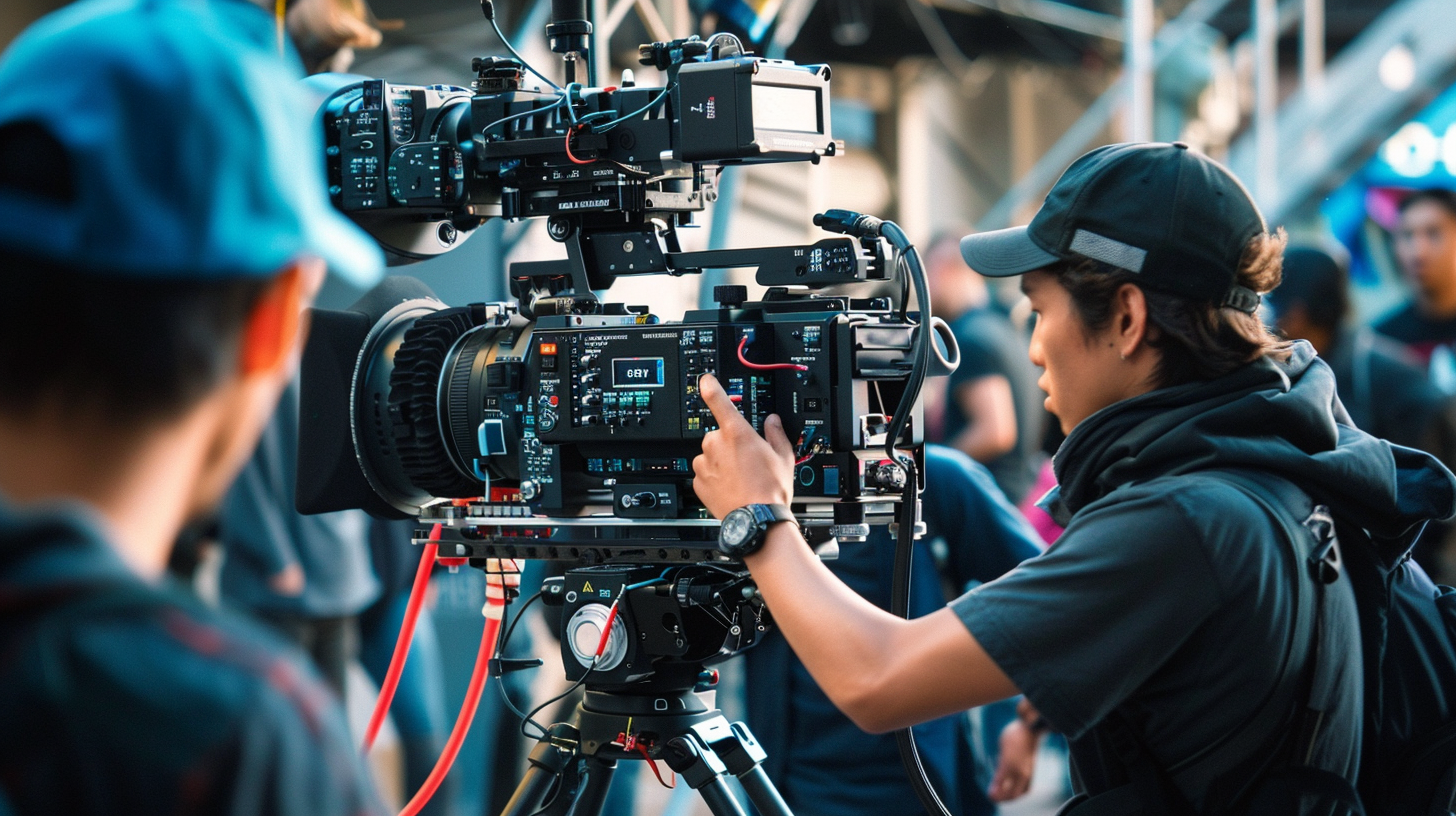Table of Contents Show
A recent study revealed that athletes who incorporate technology-driven training methods improve their performance by up to 15% more than those who stick to traditional techniques. We’re standing at the precipice of a revolution in the way we approach athletic performance, blending the pillars of training, nutrition, and cutting-edge technology. From optimizing training schedules to tailoring nutrition plans and leveraging the latest in wearable tech, the landscape is evolving rapidly. As we peel back the layers on this topic, we invite you to join us in exploring how these advancements are reshaping the world of sports, promising to push the boundaries of what we consider peak performance.
Key Takeaways
- Training principles focusing on strength, flexibility, and endurance are fundamental for athletic improvement.
- Proper nutrition, including a balance of essential nutrients, is critical for enhancing performance and recovery.
- The integration of technology, such as wearable devices and data analytics, optimizes training and competition strategies.
- Periodization and tailored training cycles are essential for achieving peak performance while preventing burnout.
Foundations of Athletic Training
To achieve peak athletic performance, we must first lay a strong foundation through effective training principles and techniques. We’re not just talking about any routine workouts; we’re diving into a world where every move counts towards unlocking our full potential. It’s about setting ourselves free from the constraints of mediocre training and embracing methods that propel us towards our goals.
We’ve got to be smart about this. It’s not just about working hard; it’s about working right. Incorporating a mix of strength, flexibility, and endurance training guarantees we’re not just powerful, but also agile and capable of sustaining our performance over time. We’re breaking free from the one-size-fits-all approach and tailoring our training to fit our unique needs and aspirations.
Let’s not forget the importance of rest and recovery. It’s tempting to push ourselves to the limit every single day, but real growth happens when we allow our bodies to recover. This doesn’t mean we’re taking the easy way out. It means we’re giving ourselves the freedom to come back stronger.
Adapting to our body’s feedback is critical. We listen, we adjust, and we overcome. It’s this flexibility that keeps us moving forward, constantly evolving our training to meet the demands of our journey.
We’re on a path to greatness, and it starts with the foundations of athletic training. It’s about embracing the freedom to explore, adapt, and ultimately, excel. Together, we’re not just chasing dreams; we’re living them.
Nutrition for Optimal Performance
As we shift our attention to nutrition for peak performance, it’s critical to understand the role of essential nutrients for athletes and the importance of effective hydration strategies in sports. We’ll explore how a well-planned diet can greatly enhance athletic capabilities and recovery times. Additionally, we’ll discuss how athletes can strategically manage their hydration to maintain peak performance during competition.
Essential Nutrients for Athletes
Athletes require a balanced intake of essential nutrients to achieve peak performance levels. We comprehend that freedom in choosing what fuels our bodies is key, but it’s also critical to be informed about what truly benefits us. Here’s a quick guide to make sure you’re getting what you need:
| Nutrient | Function | Examples |
|---|---|---|
| Protein | Muscle repair | Chicken, tofu |
| Carbohydrates | Energy source | Rice, pasta |
| Fats | Hormone production | Avocado, nuts |
| Vitamins | Immune support | Fruits, vegetables |
| Minerals | Bone health | Dairy, leafy greens |
We’re all about empowering you with knowledge so you can make the best choices for your body and performance. Remember, it’s not just about eating; it’s about fueling your freedom to excel.
Hydration Strategies in Sports
Understanding the importance of staying hydrated is essential for athletes aiming to maintain peak performance during training and competitions. We’ve learned that our bodies need the right balance of fluids to function at their best, especially when pushing the limits. Incorporating hydration strategies isn’t just about gulping water; it’s about understanding when and what to drink. We’ve found that sipping on electrolyte-infused water can be a game-changer, ensuring we’re not just hydrated but also replenishing crucial minerals lost through sweat. We also prioritize drinking at regular intervals, not waiting until we’re thirsty, to avoid dehydration. It’s about giving our bodies the freedom to perform optimally, without the constraints of poor hydration choices. This approach lets us stay focused and energized, ready to tackle any challenge.
Technology in Modern Athletics
In the domain of modern athletics, technology plays a pivotal role in enhancing both performance and training methodologies. We’ve embraced cutting-edge tools and software that not only revolutionize how athletes train but also how they recover, monitor their progress, and even compete. It’s clear that in our quest for peak performance, integrating technology is no longer optional; it’s essential.
We’re witnessing a transformation where data analytics, wearable tech, and virtual reality are not just buzzwords but integral parts of an athlete’s arsenal. These tools empower us to push beyond traditional limits, offering insights that were once unimaginable. Consider the following:
- Wearable Technology: Devices that track heart rate, sleep patterns, and activity levels, providing real-time feedback to optimize training and recovery.
- Data Analytics: Advanced software that analyzes performance metrics, helping to refine techniques, strategies, and nutrition plans.
- Virtual Reality (VR) Training: Simulated environments that enhance cognitive skills, reaction times, and even simulate competitive scenarios for mental preparation.
We’re breaking free from the constraints of conventional training methods. By harnessing technology, we’re not just improving physical performance; we’re elevating the mental game, refining strategies, and personalizing nutrition and recovery protocols. It’s about leveraging every available tool to not just meet but exceed our goals.
As we continue to explore and integrate new technologies, the potential for what we can achieve seems limitless. It’s an exciting time to be involved in athletics, where innovation opens the door to uncharted territories of performance enhancement. The freedom to push boundaries and redefine what’s possible is at our fingertips, and we’re just getting started.
Periodization and Training Cycles
While technology continues to redefine the boundaries of what athletes can achieve, it’s equally important to focus on how periodization and training cycles play a foundational role in optimizing performance. We’re diving into why these methods are essential for athletes who crave the freedom to push their limits further.
Periodization is the systematic planning of athletic training. It involves breaking down training into phases, each with a specific focus, allowing athletes to develop various physical qualities in a structured way. This approach makes sure that we’re not just working hard but also working smart. By varying the intensity and volume of training, we’re able to prevent burnout and overtraining, which are common pitfalls in the pursuit of peak performance.
Training cycles, or macrocycles, typically span several months to a year and are subdivided into smaller blocks (mesocycles) and further into weekly or daily sessions (microcycles). Each cycle targets different goals, such as building endurance, strength, or speed, leading up to peak performance for competition. This cyclical approach gives us the freedom to tailor our training according to individual needs and goals, making adjustments based on response and progress.
In short, periodization and training cycles are about empowering athletes with the structure to reach their full potential while maintaining the flexibility to adapt and evolve. It’s a dynamic process that respects the body’s need for variation, recovery, and strategic focus. As we continue to explore the science of athletic performance, let’s not forget the art of crafting a training journey that’s both effective and liberating.
Macronutrients and Athletic Needs
We’ll now explore how macronutrients play an essential role in an athlete’s diet and performance. Understanding macronutrient ratios is key to optimizing energy and recovery. We’ll also look at how nutritional timing can impact an athlete’s results.
Macronutrient Ratios Explained
Understanding the right balance of macronutrients can greatly enhance an athlete’s performance and recovery. We’ve learned that our bodies need the right mix of proteins, carbohydrates, and fats to thrive, especially under the demands of intense physical activity. But what does that mix look like?
- Proteins: Building blocks for muscle repair and growth.
- Carbohydrates: Our main source of energy, fueling both short bursts and endurance activities.
- Fats: Essential for long-term energy, supporting cell function, and hormonal balance.
We steer away from one-size-fits-all ratios. It’s about finding what liberates our bodies to perform at their peak. By listening to our needs and adjusting our intake, we unleash the full potential of our athletic capabilities without being chained to rigid dietary rules.
Nutritional Timing for Athletes
Having explored the best mix of proteins, carbohydrates, and fats, let’s now focus on when athletes should consume these macronutrients to maximize performance and recovery. Timing’s everything. We’re looking to harness the power of each meal to fuel our bodies right. Eating carbs before workouts gives us that quick energy boost, while protein post-exercise supports muscle repair and growth. Don’t forget, fats are essential too, but they’re best consumed well before intense activities since they take longer to digest. It’s not just about what we eat, but when we eat it that sets us on the path to freedom in our athletic endeavors. Let’s master the clock for our advantage, ensuring every bite takes us closer to our peak performance.
Wearables and Performance Analysis
In the domain of athletic performance, wearables have revolutionized how we analyze and enhance an athlete’s capabilities. These devices offer us a freedom previously unimaginable, allowing for real-time feedback and personalized training plans that cater directly to an athlete’s unique physiology and goals. We’re no longer bound by guesswork or one-size-fits-all approaches; the power to fine-tune every aspect of training is literally at our fingertips.
Imagine the possibilities:
- A wristband that monitors heart rate, sleep quality, and recovery, nudging us towards best wellness.
- Smart clothing that tracks muscle activity, ensuring exercises are performed with perfect form.
- Footwear equipped with sensors to analyze gait patterns, helping prevent injuries before they occur.
These tools empower us to make informed decisions about our training, nutrition, and rest. They liberate us from traditional constraints, offering a path to peak performance that is tailored, efficient, and dynamic. The data collected serves as a roadmap, highlighting strengths to build upon and weaknesses to address.
We’re now equipped to push boundaries further than ever, thanks to insights provided by wearable technology. It’s not just about working harder; it’s about working smarter. By understanding the intricacies of our bodies, we can orchestrate training regimes that propel us towards our goals while safeguarding our health.
The era of wearables in sports isn’t just coming; it’s here, and it’s transforming the landscape of athletic training. As we embrace this technology, we open a level of freedom and precision in our pursuit of excellence that was once only dreamed of.
Strength Training Essentials
As we shift our focus to strength training essentials, it’s essential we comprehend the pillars that underpin our journey: building muscle mass, mastering ideal lifting techniques, and emphasizing recovery and nutrition. We’ll explore how each component plays a crucial role in enhancing athletic performance and overall well-being. It’s not just about lifting heavier weights; it’s about doing it wisely and fueling our bodies correctly.
Building Muscle Mass
To effectively build muscle mass, incorporating strength training into your routine is essential. We’ve got to push our bodies beyond their proof zones, challenging them to adapt and grow stronger. It’s not just about lifting weights; it’s about embracing a lifestyle that celebrates progress and freedom. Here’s what we believe captures the essence of building muscle mass:
- The clank of weights as we push through another set, a proof to our dedication.
- The steady rhythm of breathing, deep and focused, as we prepare for the next challenge.
- The feeling of accomplishment that washes over us after a particularly intense session, knowing we’re a step closer to our goals.
Let’s chase that freedom, the power to shape our bodies and destinies with every rep.
Optimal Lifting Techniques
Mastering ideal lifting techniques is essential for enhancing our strength training regimen and ensuring safety during workouts. We’re all after that freedom to move, lift, and live without the constraints of injuries or limitations. It’s not just about hoisting weights; it’s about doing it right. We focus on form, engaging the right muscle groups, and maintaining a steady, controlled motion. This approach maximizes our gains and slashes the risk of injury. By perfecting our stance and breathing, we reveal the true potential of every lift. We’re not just lifting weights; we’re elevating our entire fitness journey, tapping into a world where strength and safety coexist. It’s about empowering ourselves to push further, knowing we’ve got the technique down pat.
Recovery and Nutrition
We can’t overlook the dual role of recovery and nutrition in bolstering our strength training outcomes. Embracing these elements gives us the freedom to push limits, secure in the knowledge that our bodies are supported in every phase of training.
- A sunset jog to cool down, the world quiet except for the rhythm of our breath and the distant call of the day’s end.
- The vibrant colors and fresh scents of a well-balanced meal, promising both nourishment and pleasure.
- The silent sanctuary of rest, where muscles heal and strength builds, under the soft embrace of night.
Incorporating these into our routine isn’t just about discipline; it’s about respecting our body’s needs and celebrating its capabilities, ensuring we’re always ready for the next challenge.
Hydration Strategies for Athletes
For athletes, staying adequately hydrated is an essential factor in maximizing performance and preventing injury. We comprehend the craving for freedom in training routines, and incorporating flexible hydration strategies can offer just that. It’s about knowing your body and listening to its signals, not just following a pivotal schedule.
We’ve found that starting hydration well before the actual event or training session kicks off is vital. It’s not just about gulping water right before you start; it’s a proactive approach. We encourage athletes to monitor their urine color as a quick hydration check. Light, straw-colored urine typically indicates good hydration, while darker colors suggest a need for more fluids.
During exercise, we don’t wait until we’re thirsty to drink. Thirst is a lagging indicator of dehydration. Instead, we aim for small, frequent sips of water or sports drinks, especially during long and intense sessions. This approach helps maintain electrolyte balance and prevents both dehydration and overhydration, known as hyponatremia.
Post-exercise, we focus on replenishing any fluid loss. This isn’t just about chugging water; we also consider electrolyte-rich drinks if the session was particularly grueling or if sweat loss was significant. But here’s where we embrace freedom: we listen to our bodies. Some of us prefer water, others might opt for a sports drink, and some might even choose coconut water. It’s all about what works best for you.
Recovery Technologies and Methods
Exploring recovery technologies and methods opens up new avenues for athletes to enhance their post-exercise recuperation efficiently. In the domain of athletic performance, we’re constantly seeking ways to push the boundaries of what our bodies can achieve. But to truly reveal our potential, we must prioritize recovery as much as we value training and nutrition. The freedom to train hard comes with the responsibility to recover smartly, ensuring our bodies are ready to tackle the next challenge head-on.
In this pursuit, several innovative recovery technologies and methods have emerged, offering athletes the tools they need to bounce back quicker and more effectively:
- Cryotherapy chambers: Envision stepping into a futuristic chamber, where the cold envelops you, rapidly reducing inflammation and accelerating muscle recovery. It’s like hitting a reset button for your body, making you feel rejuvenated and ready to conquer your next workout.
- Compression therapy devices: Picture sliding on a pair of high-tech compression boots that massage your legs, enhancing blood circulation and flushing out lactic acid. It’s a passive way to give your muscles the TLC they deserve, without lifting a finger.
- Electrical muscle stimulation (EMS) units: Imagine tiny electrodes gently adhering to your skin, sending stimulating pulses through your muscles. These pulses mimic the effects of a deep tissue massage, relieving soreness and improving muscle function post-exercise.
We’re arming ourselves with these tools not just to recover, but to revolutionize the way we train and perform. By embracing these recovery technologies and methods, we’re not only investing in our current performance but also safeguarding our athletic future, ensuring we’re always ready to embrace the freedom of pushing our limits.
Psychological Aspects of Training
Shifting our focus to the mental battlefield, it’s clear that psychological resilience plays a significant role in maximizing athletic performance. We’ve discovered that mindset isn’t just a small part of training; it’s the backbone. Athletes who cultivate a strong mental game find themselves not just surviving but thriving in the face of adversity. They embrace challenges, learn from failures, and keep pushing their limits.
To create a rhythm and flow in understanding, here’s how psychological aspects break down:
| Aspect | Benefit | Practical Application |
|---|---|---|
| Goal Setting | Focuses effort and motivation | Set SMART goals |
| Visualization | Enhances technique and confidence | Mental rehearsal of success |
| Mindfulness | Improves concentration and control | Practice meditation and breathing exercises |
| Positive Self-Talk | Boosts confidence and reduces anxiety | Replace negative thoughts with constructive ones |
Incorporating these strategies into daily training routines empowers athletes. It’s not just about the physical grind; it’s about mastering the mental game. By setting specific, measurable, achievable, relevant, and time-bound (SMART) goals, athletes can channel their efforts more effectively. Visualization, or the mental rehearsal of success, primes the mind for victory, making the imagined success more attainable.
Mindfulness and positive self-talk are about reclaiming control. They allow athletes to focus on the present and silence the inner critic, turning potential barriers into stepping stones toward triumph. We encourage athletes to embrace these practices, not just for their sport, but for the freedom it brings to their lives.
Enhancing Endurance and Stamina
Having covered the mental strategies that shape a strong athletic mindset, we now turn our attention to the physical counterpart, focusing on how to enhance endurance and stamina. We’re in this together, seeking the freedom that comes from pushing our bodies beyond their limits, exploring how we can sustain longer periods of physical activity without succumbing to fatigue.
First and foremost, it’s important to understand that improving endurance and stamina isn’t just about running longer or lifting more; it’s about training smarter. Here are a few strategies we’ve found effective:
- Incorporate Interval Training: Short bursts of high-intensity exercise followed by brief rest periods can significantly boost cardiovascular health, enhancing one’s ability to endure more extended periods of exercise.
- Master Your Breathing Techniques: Proper breathing ensures your muscles receive the oxygen they need to perform. Focusing on deep, rhythmic breaths can improve stamina and prevent the early onset of fatigue.
- Optimize Your Nutrition: Fueling your body with the right nutrients before, during, and after exercise can make a substantial difference in your performance and recovery.
We’re all after that exhilarating sense of freedom that comes from breaking our personal records, from feeling our lungs expand with every breath and our muscles propel us further than we thought possible. By focusing on these key areas, we’re not just training our bodies; we’re redefining our limits. Let’s embrace the journey of enhancing our endurance and stamina, stepping into a world where we’re no longer bound by yesterday’s capabilities but are continuously striving for tomorrow’s possibilities.
Future Trends in Athletic Science
As we explore the future trends in athletic science, it’s clear that technology and innovative training methods are set to redefine how athletes train and perform. We’re moving towards a world where personal freedom and tailored experiences aren’t just desires—they’re expectations. This shift is evident as we investigate into the areas of wearable tech, AI coaches, and nutrition plans customized down to the DNA level.
We’re not just talking about tracking steps and heart rates anymore. We’re looking at sensors that monitor muscle fatigue, recovery needs, and even predict potential injuries before they happen. This means athletes can push themselves to the limit, knowing they’re doing it safely and effectively.
AI and machine learning aren’t far behind. Imagine having a coach that understands your body better than you do, offering real-time adjustments to your training regimen based on your performance, mood, and overall health. This isn’t just about improving physical performance; it’s about ensuring mental well-being too.
Nutrition is getting a futuristic overhaul as well. We’ll see diets optimized based on individual genetic makeup, offering unparalleled insights into what fuels each athlete best. This level of customization guarantees that every bite contributes to peak performance.
In the pursuit of freedom and excellence, the future of athletic science promises a world where every athlete has the tools, knowledge, and support to explore the limits of their capabilities. We’re on the brink of a revolution, and it’s one that celebrates the unique potential within each of us, freeing athletes to achieve their absolute best.
Conclusion
To sum up, we’ve journeyed through the intricate tapestry of athletic science, weaving together threads of training, nutrition, and technology. Like a well-oiled machine, these components work in harmony to propel athletes to their peak. The future of athletic science shines brightly, promising innovations that will continue to push the boundaries of human performance. Together, we stand on the precipice of discovery, ready to leap into the unknown and redefine the limits of what’s possible. Let’s embrace this adventure with open arms and relentless determination.








